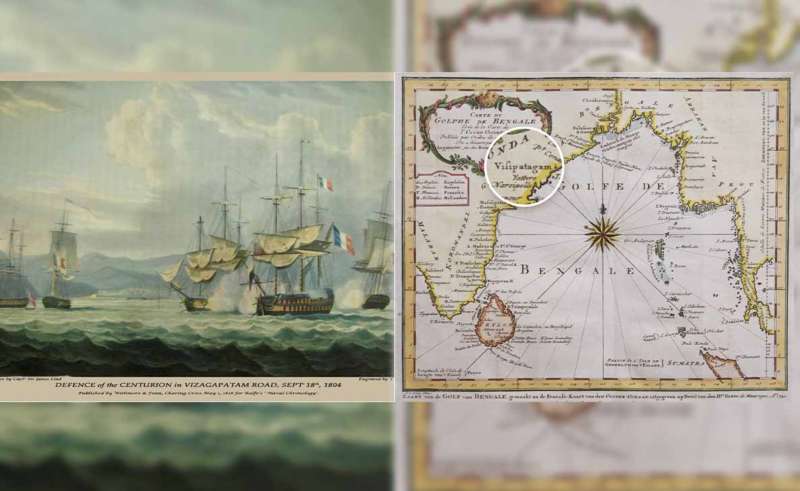
Vizag, once known as Vizagapatam, has a long history and innumerable untold stories to its name. One such story is how Vizag almost turned into Province de Bonaparte. Imagine the metamorphosis the city would have had to go through had there been French rule in Vizag and not the British. Vizag would have been an exact or a nearly exact replica of Pondicherry, instead of adorning the buildings built during the British rule.
Here is the story of how the British aided in ending the French rule in Vizag.
In the mid-1700s, Vizag was on the cusp of becoming a French colony but a twist of fate changed the course of Vizag’s history. The first major exploratory voyage made by the French to the Bay of Bengal was in 1740, by the sailor Jacques-Nicolas Bellin, who was the French East India Company’s cartographer. Vifipatagam, on the western shore of the Golfe de Bengale, is how the mapmaker wrote the town’s name at that time.
A big clue to how close Vizag came to being a French colony was on India’s Coromandel Coast and centred in Pondicherry. It was from there in 1757 that Marquis de Bussy launched his military action into the Northern Circars against the English. The stronger clue is closer in Vizianagaram, from where the Rajah and his French ally lay siege. Eventually, they overran the ill-equipped English Fort and Factory of Vizagapatam. The early maps of Vizag are from French military mapmakers who charted the old town and fort for this campaign.
It was fate that the Rajah of Vizianagram, Pedda Vizayarama Raju was assassinated during the conflict with Bobbili in 1757. His successor, Ananda Raju III suspected Bussey and the French of this act and became antagonistic towards his ally. He then made approaches to the English and immediately set about to liberate Vizagapatam from the French. On 15 November 1758, a treaty was concluded between the English and Anand Raju which made them equal partners in their mission of ousting the French from the Northern Circars.
The French Revolutionary War, fought between 1793 and 1801, was between the new French Republic and an alliance of rival powers. Although the principal theatre of the conflict in Western Europe, the colonies in India played a significant role. This was due to the economic importance of the region to England, which was France’s most constant military opponent and far eastern trade rival.
Peace after the Revolutionary War was short-lived as the Napoleonic war erupted in May 1803. Emperor Napoleon had sent substantial reinforcements to Île de France (Mauritius) and other French territories in the East Indies. The Bay of Bengal was the theatre for many naval actions between the Royal Navy and East India Company vessels against the French Navy and privateers.
Later in 1804, unfamiliar tall ships sailed up the Coromandel Coast. To the Vizag fisher folk, every such ship looked the same, but this time the red, white and blue that hung from the flagstaff were not the Union Jack. These were the ships Marengo, L’Atlante and La Sementalle, flying the French tricolour. They were sent by Napoleon to scout the southern oceans, which eventually led to the Battle of Vizagapatnam Roads on 18 September 1804. The English prevailed in the Napoleonic War, with the Allies defeating Napoleon permanently at Waterloo in June 1815 and exiling him to St Helena.
It is hard to imagine a French Vizag. Perhaps the coffee culture would be roughly the same instead of tea, but would cricket and hockey still be played? Or would soccer, tennis and cycling be our sporting obsessions? Would we have developed a taste for wine and cheese? Would we be the Province de Bonaparte
instead of the District of Vizagapatam? Would Dolphin’s Nose be Nez du Dauphin? Or would we all be speaking French with our own distinct Indian accent, like French speakers in Pondicherry and Mauritius? These questions would have been answered but for a small change in history thanks to fate and the zeal of the Maharajah of Vizianagram that carved the future course of Vizag.How very different things might have been and we could well have been saying Viva la France and Je Suis Vizag
Should you have an anecdote or history on Vizag, the author would appreciate you to contact him at jcastell@ozemail.com.au
Written by John Castellas whose family belonged to Vizag for 5 generations. Educated at St Aloysius, migrated to Melbourne, Australia in 1966, former General Manager Engineering at Boeing & Qantas Airways, in retirement Lecturers in Aviation Management at Swinburne University and is a Vizag aficionado.
What could possibly link Vizag, a quaint coastal town nestled on India's Eastern Coast, with…
The Earth is gorgeous - it's in the golden rays of the sun at the…
On April 27, 2024, YS Jagan Mohan Reddy, the Chief Minister of Andhra Pradesh, unveiled…
Andhra Pradesh Chief Minister Y S Jaganmohan Reddy on Saturday, 27 April 2024, released the…
With the weekend here, it's time to put the seriousness aside and put our funny…
The cacophony of poll campaigns in Visakhapatnam, Andhra Pradesh gets louder as D-Day for the…
Leave a Comment